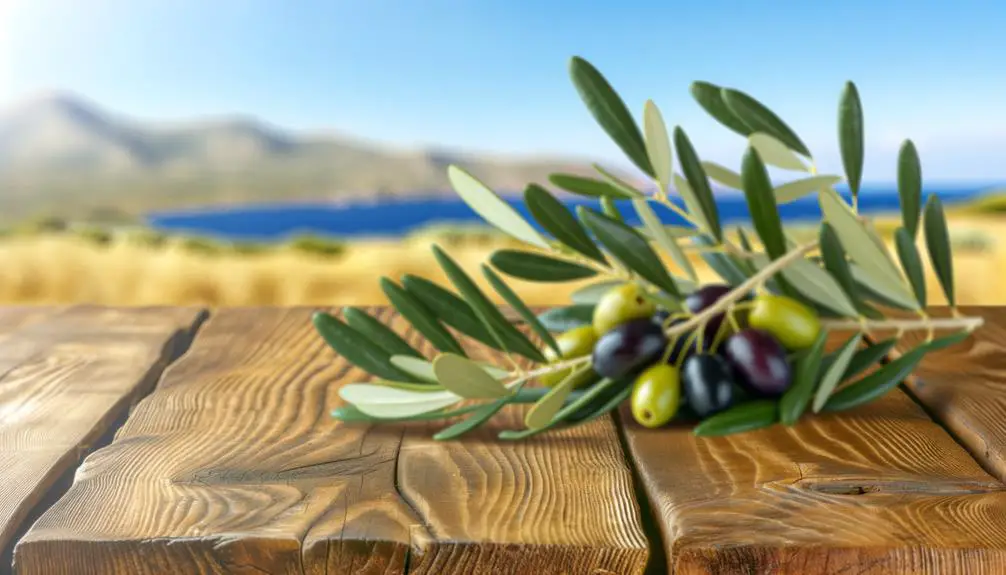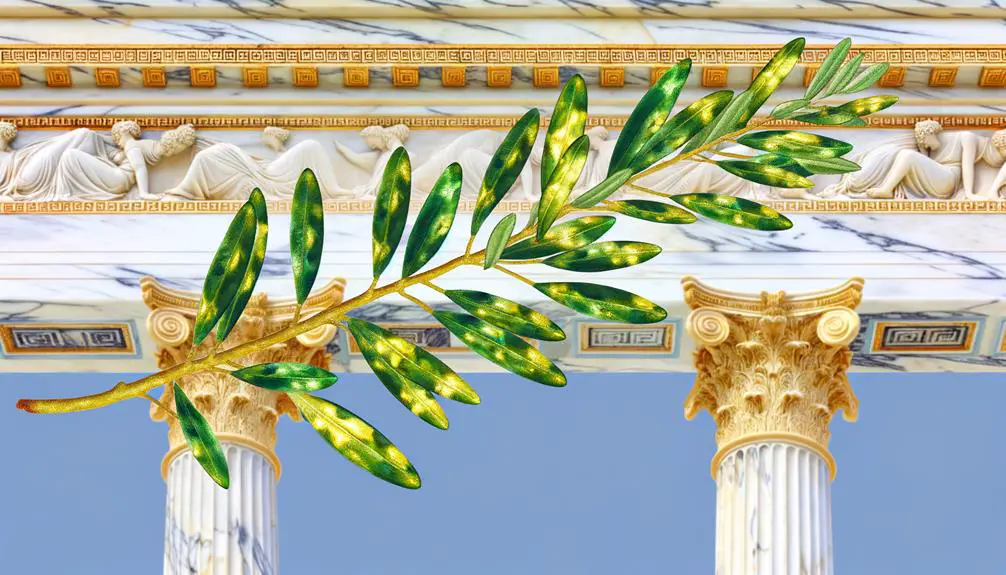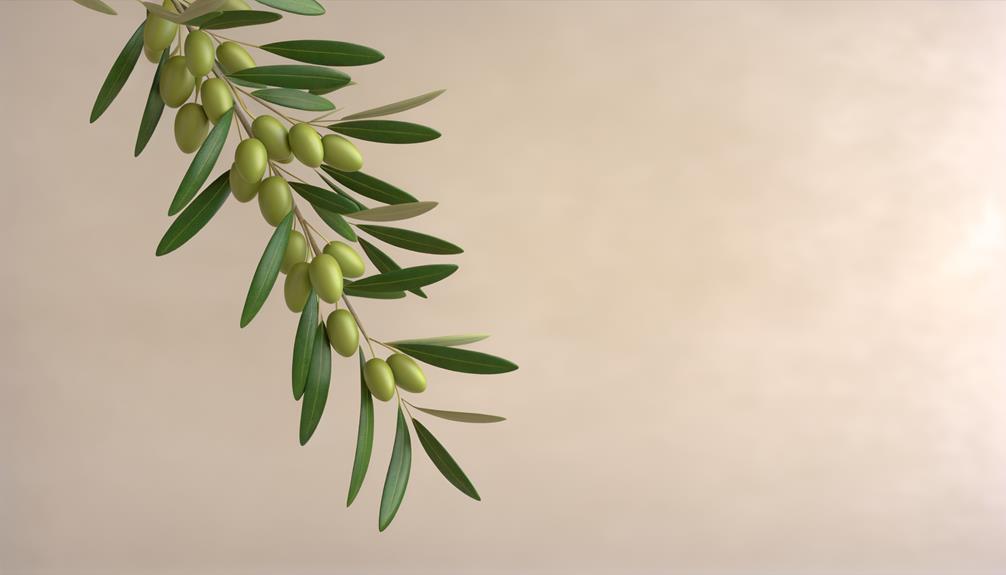Using the Olive Branch Symbol in Modern Peace Initiatives
The olive branch, revered since ancient times, symbolizes peace, victory, and reconciliation. In Greek culture, it is linked to the goddess Athena and denoted civic harmony and martial prowess.
Biblically, it represents reconciliation and divine promise, notably in the story of Noah's Ark. Artistic depictions from classical antiquity to the Renaissance highlight its universal appeal for peace.
In modern diplomacy, it remains a potent emblem of negotiation and conflict resolution. Contemporary global culture continues to embrace the olive branch as a symbol of truce and understanding, evident in literature, art, and international organizations.
Discover more about its enduring symbolism in various contexts.

Key Takeaways
- The olive branch symbolizes peace and victory in ancient Greek culture.
- In the Bible, it represents reconciliation and divine promise, notably in the story of Noah's Ark.
- Artistic depictions use the olive branch to convey peace, victory, and reconciliation across various eras.
- Modern diplomacy employs the olive branch as a symbol of negotiation and commitment to resolving conflicts.
- Today, the olive branch is a universal emblem of peace and reconciliation, recognized globally.
Ancient Greek Origins

The olive branch as a symbol of peace and victory can be traced back to ancient Greek culture, where it was associated with the goddess Athena and the city-state of Athens. Athena, the deity of wisdom and warfare, was believed to have gifted the olive tree to the city, symbolizing prosperity and harmony.
The olive branch, as a result, became emblematic of peaceful resolutions and triumphs. In ancient Greek athletic competitions, victors were often crowned with olive wreaths, further cementing the branch's status as a symbol of victory. This cultural practice underscored the dual symbolism of peace and success intertwined with the olive branch, reflecting the Greeks' reverence for both martial prowess and civic tranquility.
Biblical References
While the ancient Greeks solidified the olive branch as a symbol of peace and victory, its resonance also extends into Biblical narratives, where it embodies themes of reconciliation and divine promise.
The most notable reference appears in the story of Noah's Ark, where a dove returns with an olive branch, signaling the end of the flood and God's covenant with humanity. This association underscores the olive branch's enduring significance.
Key Biblical references include:
- Genesis 8:11: The dove with an olive leaf.
- 1 Kings 6:23-33: Olive wood used in Solomon's temple.
- Psalm 52:8: The righteous as a flourishing olive tree.
- Romans 11:17-24: Olive tree as a metaphor for spiritual grafting.
These references highlight its multifaceted symbolism in Biblical contexts.
Symbolism in Art
Frequently depicted in various art forms, the olive branch has served as a powerful symbol conveying themes of peace, victory, and reconciliation throughout history. In classical antiquity, artists often illustrated the olive branch in the hands of deities or victorious generals, signifying triumph and divine favor.
Renaissance paintings similarly utilized the motif to emphasize themes of harmony and resolution, often in religious or mythological contexts. The olive branch's presence in visual art transcends cultural boundaries, appearing in works from Greco-Roman mosaics to modern-day murals.
Its enduring relevance in art underscores its universal appeal and the human aspiration for peace. By analyzing these artistic representations, one gains insight into the collective psyche and societal values across different epochs and cultures.
Modern Diplomatic Uses
In contemporary diplomacy, the olive branch serves as a potent emblem of peace and negotiation, symbolizing a commitment to resolving conflicts through dialogue and mutual understanding. This symbol's modern relevance is evident in various diplomatic practices and gestures, underscoring its enduring significance.
Key examples include:
- Official Peace Treaties: The olive branch is often incorporated into the visual and textual elements of peace agreements.
- Diplomatic Gifts: Heads of state exchange olive branches or items depicting them as tokens of goodwill.
- International Organizations: The United Nations and other bodies use the olive branch in their logos to emphasize peacekeeping missions.
- Public Statements: Leaders invoke the olive branch metaphor in speeches to signal a desire for reconciliation.
This usage highlights the olive branch's role in fostering international harmony.
Cultural Significance Today

The olive branch continues to hold profound cultural significance today, representing peace and reconciliation across various societies and traditions. In contemporary global culture, it often appears in logos of international organizations, such as the United Nations, symbolizing their commitment to global harmony.
Additionally, the olive branch is frequently used in literature, art, and media to convey themes of truce and understanding. Its emblematic use transcends geographical boundaries, appearing in ceremonies and rituals aimed at conflict resolution.
The widespread recognition of the olive branch underscores its enduring symbolism, despite evolving social contexts. This persistent relevance highlights humanity's enduring aspiration for peace, making it a powerful and universal icon in our collective cultural consciousness.
Conclusion
The olive branch, with its origins in ancient Greece and references in biblical texts, has evolved into a powerful symbol of peace and reconciliation in art and diplomacy.
Its enduring significance is evidenced by its use in the United Nations emblem, symbolizing global unity and harmony.
Curiously, a 2017 survey found that 62% of nations incorporate the olive branch in their official symbols.
This statistic underscores the universal appeal and deep-rooted cultural resonance of the olive branch across diverse societies.






